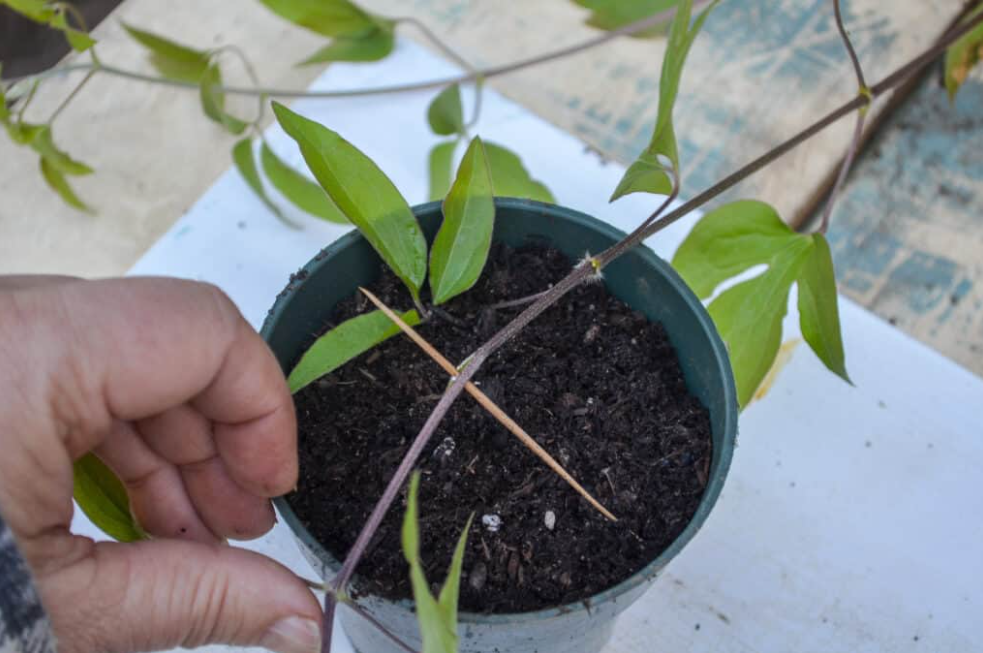How to Grow Clematis from Cuttings Step By Step
There are more than 300 species of clematis (Clematis spp.) flowering vines growing around the world. Depending on the variety, these perennials produce blooms from spring to fall in U.S. Department of Agriculture plant hardiness zones 3 through 8. Propagation of clematis vines takes at least three years from seed to bloom. Shorten the growing period by starting clematis tip cuttings in water.

Rooting Vessels and Water
The rooting vessel can be any jar, vase, or container that is clear and holds water. A mason jar or tall baby food jar works to root the clematis tip cuttings in water. The container should be tall enough to support the vine when the tip cutting is inserted into the container but short enough that the top leaves are above the rim of the vessel. Use distilled water to fill the container about two-thirds full. Drop an aspirin in the water and stir until it dissolves. The aspirin aids in water rooting.
Tip Cuttings
The firm green cuttings taken from the tip of the clematis stems root more readily than those taken from a brown woody part of the plant. Choose healthy vines that are free from any disease or pest infestation. Make the cutting at least 6 to 8 inches long. The leaves must be removed from the vine where the cutting will be submerged in the water, or the leaves will rot. Remove any flower buds or blossoms so the vine focuses energy on producing roots instead of blooming.
Tip Cutting Care
A sunny window that faces North gives the clematis tip cutting enough light to generate the energy needed for root growth. The stem rots or does not produce roots if you put the container in a shady window. Supplement the natural light with a grow light suspended 6 inches above the cutting if you do not have a bright window.
Change the water every day to keep it from turning stagnant. Replace the aspirin each day that you change the water. Remove any leaves that may drop into the water from the upper portion of the stem.
Transferring From Water to Soil
The roots formed on the clematis tip cutting in water are made to gather nutrients from the water, not the soil. If you put the rooted cutting directly into the soil, the cutting cannot absorb the oxygen needed to survive. You must introduce the roots to the soil slowly. When the roots are about 1/4 o 1 inch long, add a tablespoon of potting soil to the water. Continue adding potting soil, one tablespoon at a time, each day until there is more soil than water. Once the soil is in the water, the roots that form will adapt.
Transplanting Clematis Plants
Once the new clematis vine starts growing, slowly acclimate it to the outdoors. Transplant the vine to a pot, and set it in a shady area of the landscape for a few hours each day. Move the vine to a sunnier area each day. Transplant the vine to the permanent location once the vine can withstand 24 hours outdoors in the bright sunlight.
Flower Patch Farmhouse
Propagate Clematis by Layering
A very popular vine grown in cottage gardens is clematis. There is such a wide variety of clematis you can grow and enjoy. Did you know you can easily propagate clematis by layering? Read on and you can learn step by step!
In a previous post, you learned how to Propagate Roses by Air Layering and it now has become a favorite way of rooting roses. To propagate clematis by layering you use the same principle but it is done a little differently.
Leaf-bud cuttings (a form of softwood cuttings) can be taken from any clematis and are a quick and easy to way to boost the stock of your favorite clematis.

When selecting a section to take cuttings from, find a strongly-growing stem and target a leaf bud that’s not too soft, and not too woody. This will likely be from the mid-section of the plant. Once the stems have rooted (usually after about four weeks) shoots will grow from the axils of the leaves at the top.
New to growing clematis? Here are 10 pretty summer clematis to grow, plus some growing tips.
Learn how easy it is to take clematis cuttings, below.
Leaf-bud cuttings can be taken from any clematis and are a quick and easy to way to boost the stock of your favorite clematis.
There are more than 300 species of clematis (Clematis spp.) flowering vines growing around the world. Depending on the variety, these perennials produce blooms from spring to fall in U.S. Department of Agriculture plant hardiness zones 3 through 8. Propagation of clematis vines takes at least three years from seed to bloom. Shorten the growing period by starting clematis tip cuttings in water.
Rooting Vessels and Water
The rooting vessel can be any jar, vase or container that is clear and holds water. A mason jar or tall baby food jar works to root the clematis tip cuttings in water. The container should be tall enough to support the vine when the tip cutting is inserted into the container but short enough that the top leaves are above the rim of the vessel. Use distilled water to fill the container about two-thirds full. Drop an aspirin in the water and stir until it dissolves. The aspirin aids in water rooting.
Tip Cuttings
The firm green cuttings taken from the tip of the clematis stems root more readily than those taken from a brown woody part of the plant. Choose healthy vines that are free from any disease or pest infestation. Make the cutting at least 6 to 8 inches long. The leaves must be removed from the vine where the cutting will be submerged in the water, or the leaves will rot. Remove any flower buds or blossoms so the vine focuses energy on producing roots instead of blooming.
Tip Cutting Care
A sunny window that faces North gives the clematis tip cutting enough light to generate the energy needed for root growth. The stem rots or does not produce roots if you put the container in a shady window. Supplement the natural light with a grow light suspended 6 inches above the cutting if you do not have a bright window.
Change the water every day to keep it from turning stagnant. Replace the aspirin each day that you change the water. Remove any leaves that may drop into the water from the upper portion of the stem.
Transferring From Water to Soil
The roots formed on the clematis tip cutting in water are made to gather nutrients from the water, not the soil. If you put the rooted cutting directly into the soil, the cutting cannot absorb the oxygen needed to survive. You must introduce the roots to the soil slowly. When the roots are about 1/4 o 1 inch long, add a tablespoon of potting soil to the water. Continue adding potting soil, one tablespoon at a time, each day until there is more soil than water. Once the soil is in the water, the roots that form will adapt.
Transplanting Clematis Plants
Once the new clematis vine starts growing, slowly acclimate it to the outdoors. Transplant the vine to a pot, and set it in a shady area of the landscape for a few hours each day. Move the vine to a sunnier area each day. Transplant the vine to the permanent location once the vine can withstand 24 hours outdoors in the bright sunlight.
A very popular vine grown in cottage gardens is clematis. There is such a wide variety of clematis you can grow and enjoy. Did you know you can easily propagate clematis by layering? Read on and you can learn step by step!
In a previous post, you learned how to Propagate Roses by Air Layering and it now has become a favorite way of rooting roses. To propagate clematis by layering you use the same principle but it is done a little differently
Bury the slice of clematis vine to root
The pots are already placed into the soil around the base of the mother plants and have some moist potting soil in them. Or your soil has been loosened and ready to plant into.
Gently press the sliced part of the stem into the soil (careful clematis can snap so easily) and cover with more potting soil or soil.
This part is actually much easier on the ground than in a pot unless you have buried your pot. I like using pots as I find it a bit easier to dig them back up. In the ground, I am not sure how deep the roots go. But in the long run, clematis can be tough






